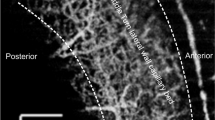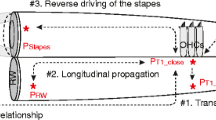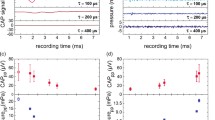Summary
This study examined the effects of acoustic exposure at different intensities on cochlear blood flow (CBF) using laser Doppler flowmetry. CBF was measured in anesthetized guinea pigs exposed to either a 10 kHz pure tone at 125, 105, or 90 dB SPL, or wide-band noise at 85 dB SPL for 1 h. Mean arterial blood pressure and heart rate were recorded continuously. Arterial acid-base status, cochlear temperature, cochlear microphonics (CM), and compound action potentials (CAP) were measured before and after exposure. There was a small, but significant, steady decline in basal CBF after 40 min loud sound exposure (125 dB SPL), but no change in basal CBF occurred with the lower intensities (85–105 dB SPL). In contrast, there was a significant increase in apical CBF after 1 h exposure to either moderate wideband noise (85 dB SPL) or a 10 kHz tone at 105 dB SPL. These changes persisted during a 20-min post-exposure period. In most cases, the cochlear temperature and cardiorespiratory variables monitored remained unchanged during and after the exposures as compared to the controls. CM and CAP amplitudes showed extensive losses after acoustic overstimulation (125 dB SPL), but no permanent changes were found at the lower intensities used. The present findings confirm the occurrence of intensity-related effects of acoustic exposure on the cochlear microcirculation.
Similar content being viewed by others
References
Angelborg C, Hultcrantz E, Beausang-Linder M (1979) The cochlear blood flow in relation to noise and cervical sympathectomy. Adv Otorhinolaryngol 25:41–48
Axelsson A, Vertes D (1982) Histological findings in cochlear vessels after noise. In: Hamernik RP, Henderson D, Salvi R (eds) New perspectives on noise induced hearing loss. Raven Press, New York, pp 49–67
Bohne B-D, Rolle W, Strobl R, Ulrich W-D (1973) Mantel-Thermoelemente zur Temperaturmessung in Medizin and Biologie. Medizintechnik 13:13–16
Canlon B, Schacht J (1983) Acoustic stimulation alters deoxyclucose uptake in the mouse cochlea and inferior colliculus. Hear Res 10:217–226
Canlon B, Takada A, Schacht J (1984) Glucose utilization in the auditory system: cochlear dysfunctions and species differences. Comp Biochem Physiol 78A:43–47
Dengerink HA, Axelsson A, Miller JM, Wright JW (1984) The effect of noise and carbogen on cochlear vasculature. Acta Otolaryngol(Stockh) 98:81–88
Dengerink HA, Miller JM, Axelsson A, Vertes D, Dalfsen P van (1985) The recovery of vascular changes following brief noise exposure. Acta Otolaryngol (Stockh) 100:19–25
Goodwin PC, Ryan AF, Sharp FR, Woolf NK, Davidson TM (1984) Cochlear deoxyglucose uptake: relationship to stimulus intensity. Hear Res 15:215–224
Haupt H, Scheibe F, Ludwig C (1988) Oxygen tension in the perilymph of sound-exposed guinea pigs. In: Loebe L-P, Lotz P (eds) VIII International Cochlea Symposium 1987. MartinLuther-Universität, Wiss. Beitrage 1988/15 (R 104), Halle (Saale), Germany, pp 93–95
Haupt H, Scheibe F, Ludwig C, Petzold D (1991) Measurements of perilymphatic oxygen tension in guinea pigs exposed to loud sound. Eur Arch Otorhinolaryngol 248:413–416
Hawkins JE (1971) The role of vasoconstriction in noise-induced hearing loss. Ann Otol Rhinol Laryngol 80:903–913
Hultcrantz E (1979) The effect of noise on cochlear blood flow in the conscious rabbit. Acta Physiol Scand 106:29–37
Hulterantz E, Angelborg C, Beausang-Linder M (1979) Noise and cochlear blood flow. Arch Otorhinolaryngol 224:103–106
Kawata S, Morimitsu T, Matsuo K, Suga F, Morizono T, Nakashima T, Matsumoto I, Nagashima H (1967) Relationship between blood flow and bioelectric functions of the cochlea. Otol Fukuoka 13 [Suppl 1]:9–28
Maass B, Baumgdrtl H, Lübbers DW (1978) Lokale PO2- und PH2-Messungen mit Mikrokoaxialnadelelektroden an der Basalwindung der Katzencochlea nach akuter oberer zervikaler Sympathektomie. Arch Otorhinolaryngol 221:269–284
Meyer P, Kuhl K-D, Schmidt R, Grützmacher W (1991) Guinea pig cochlear blood flow under definite sound exposure — hydrogen clearance measurement. ORL 53: 327–330
Misrahy GA, Arnold JE, Mundie JR, Shinabarger EW, Garwood VP (1958) Genesis of endolymphatic hypoxia following acoustic trauma. J Acoust Soc Am 30:1082–1088
Morimitsu T, Matsuo K, Suga F (1965) Behavior of the cochlear blood flow. Ann Otol Rhinol Laryngol 74:22–32
Morizono T (1966) Influences of electric hypothalamic stimulation upon cerebral and cochlear micro blood circulation. Otol Fukuoka 12:5–32
Okamoto A, Tamura T, Yokoyama K, Kobayashi N, Hasegawa M (1990) Effect of loud sound exposure on the cochlear blood flow. Acta Otolaryngol (Stockh) 109:378–382
Perlman HB, Kimura R (1962) Cochlear blood flow in acoustic trauma. Acta Otolaryngol (Stockh) 54:99–110
Prazma J, Rodgers GK, Pillsbury HC (1983) Cochlear blood flow: effect of noise. Arch Otolaryngol 109:611–615
Prazma J, Vance SG, Bolster DE, Pillsbury HC, Postma DS (1987) Cochlear blood flow: the effect of noise at 60 minutes' exposure. Arch Otolaryngol Head Neck Surg 113:36–39
Quirk WS, Shapiro BD, Miller JM, Nuttall AL (1991) Noise-induced changes in red blood cell velocity in lateral wall vessels of the rat cochlea. Hear Res 52:217–224
Ryan AF, Goodwin P, Woolf NK, Sharp F (1982) Auditory stimulation alters the pattern of 2-deoxyglucose uptake in the inner ear. Brain Res 234:213–225
Ryan AF, Axelsson A, Myers R, Woolf NK (1988) Changes in cochlear blood flow during acoustic stimulation as determined by 14C-iodoantipyrine autoradiography. Acta Otolaryngol (Stockh) 105:232–241
Scheibe F, Haupt H, Ludwig C (1986) Perilymphatic oxygen tension and cochlear blood flow in guinea pigs exposed to loud sound (abstract). 23rd Workshop on Inner Ear Biology, Berlin, Germany. ENT Department Charité, Humboldt University, Berlin, p 46
Scheibe F, Haupt H, Ludwig C (1988) Laser Doppler measurement of cochlear blood flow during sound exposure. In: Loebe L-P, Lotz P (eds) VIII International Cochlea Symposium 1987. Martin-Luther-Universitat, Wiss. Beiträge 1988/15 (R 104), Halle (Saale), Germany, pp 87–89
Scheibe F, Ludwig C, Haupt H, Flemming B (1989) Physiologische Parameter des Meerschweinchens unter Langzeitnarkose mit kontrollierter Beatmung. Z Versuchstierkd 32:25–31
Scheibe F, Haupt H, Nuttall AL, Ludwig C (1990) Laser Doppler measurements of cochlear blood flow during loud sound presentation. Eur Arch Otorhinolaryngol 247:84–86
Scheibe F, Haupt H, Ludwig C (1992) Intensity-dependent changes in oxygenation of cochlear perilymph during acoustic exposure. Hear Res 63: 19–25
Smith DI, Lawrence M, Hawkins JE (1985) Effects of noise and quinine on the vessels of the stria vascularis: an image analysis study. Am J Otolaryngol 6:280–289
Suga F (1962) Cochlear functions and cochlear blood flow in acoustic trauma. Otol Fukuoka 8 [Suppl 3]:187–202
Thorne PR, Nuttall AL (1986) Changes in blood flow and oxygen tension in the guinea pig cochlea during loud sound exposure (abstract). 23rd Workshop on Inner Ear Biology; Berlin, Germany. ENT Department Charité, Humboldt University, Berlin, p 43
Thorne PR, Nuttall AL (1987) Laser Doppler measurements of cochlear blood flow during loud sound exposure in the guinea pig. Hear Res 27:1–10
Vertes D, Axelsson A, Miller JM, Lidén G (1981) Cochlear vascular and electrophysiological effects in the guinea pig to 4kHz pure tones of different durations and intensities. Acta Otolaryngol (Stockh) 92:15–24
Wagner H, Berndt H, Gerhardt H-J (1974) Zur Erzeugung kalibrierter Schallpegel am Trommelfell des Meerschweinchens. Arch Otorhinolaryngol 206:283–292
Author information
Authors and Affiliations
Additional information
Dedicated to Prof. H. J. Gerhardt on his 65th birthday
Correspondence to: F. Scheibe
Rights and permissions
About this article
Cite this article
Scheibe, F., Haupt, H. & Ludwig, C. Intensity-related changes in cochlear blood flow in the guinea pig during and following acoustic exposure. Eur Arch Otorhinolaryngol 250, 281–285 (1993). https://doi.org/10.1007/BF00186226
Received:
Accepted:
Issue Date:
DOI: https://doi.org/10.1007/BF00186226




